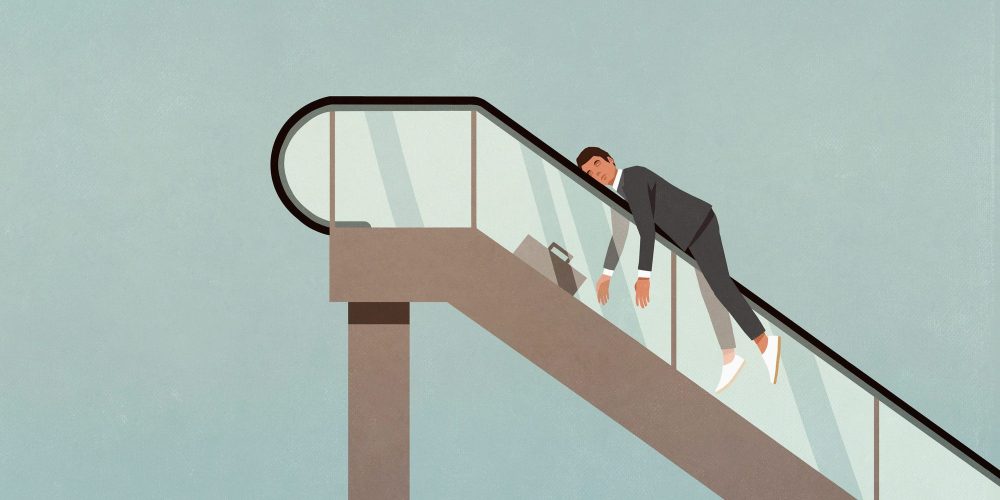Ariane Ollier-Malaterre answered my call from Canada. “It’s a holiday here today,” she told me: The National Holiday of Quebec. She had the day off from teaching at the University of Quebec in Montreal’s School of Management.
Never mind that Ollier-Malaterre studies the future of work, focusing specifically on how people set boundaries between their personal and professional lives. She was excited to share some of her research findings, and getting on a 30-minute call from home seemed easy enough.
This blurring of boundaries is a trap Ollier-Malaterre knows that others will fall into as well.
She is especially worried now that many people are returning to the office after more than a year of working remotely. She keeps picturing a nightmare scenario in which employees commute to the office, spend a full day there, and then return home just to continue answering emails and calls.
“It would be the worst of both worlds,”
for employers and employees, Ollier-Malaterre said. She and some colleagues are calling it the post-pandemic
burnout wave.
Preliminary data supports Ollier-Malaterre’s hunch. In an Insider survey of 1,000 employed Americans across the country, 72% of respondents who are returning to an office after working remotely said they’re feeling burned out. That’s compared to 60% of those who have been going into the office consistently and 65% of those who are working in a hybrid setup.
The World Health Organization defines burnout as
workplace stress that has not been successfully managed.
Its three components, according to the WHO, are exhaustion, cynicism, and diminished performance. Reports of burnout across industries like finance, consulting, and tech have increased rapidly.
As employers across the US start calling people back to the office, we could see these symptoms blanket the American workforce. Put frankly: The Great American Burnout might be just getting started. To keep that trend in check, both employers and employees need to be deliberate about articulating what’s working and what isn’t.

There’s implicit and explicit pressure to return to the office
In many parts of the US, life is returning to some semblance of normal. Vaccinated family and friends are reuniting; offices are gradually reopening. But feelings of liberation during this transition period might be coupled with feelings of burnout. Nearly half of respondents in the Insider survey who said they were at least a little burned out said they started feeling that way within the past few months.
The pressure to come back to the office might be a factor.
Sometimes that pressure is implicit. Research suggests that remote workers tend to have worse career prospects than their in-office counterparts.
And sometimes that pressure is explicit. WeWork CEO Sandeep Mathrani said people who prefer to work from home are generally the “least engaged” at their companies. JPMorgan CEO Jamie Dimon said working from home “does not work for young people” or “those who want to hustle.”
But most professionals say they’d prefer some amount of flexibility. The workplace technology firm Envoy found that 48% of 1,000 US workers surveyed would prefer a mix of working remotely and in the office. In a survey by Morning Consult, 39% of 1,000 US adults said they’d consider quitting if their managers didn’t let them work from home at least occasionally.
That tension between what your employer wants — or demands — and what you know works best for your lifestyle can result in stress, anxiety, and possibly burnout.
Employees’ values and habits changed during the pandemic
The pandemic changed people’s habits, routines, and even personalities. As Insider’s Rebecca Knight reported, some people reconnected with their own values and interests.
Which means the work experience that satisfied someone pre-pandemic might not satisfy them now.
The person that left to start working at home is not the person who’s coming back to the office,
said Steve Cadigan, who runs the consultancy Cadigan Talent Ventures and is the author of the forthcoming book “Workquake.” Maybe, Cadigan said, they’ve lost someone to COVID-19; maybe they have young kids and are concerned about their education; maybe they’ve simply discovered that they love working remotely.
People’s overall habits and routines have been completely upended
during the pandemic, said Tsedal Neeley, a professor at Harvard Business School and the author of “Remote Work Revolution.” In Neeley’s research, one employee told her that coming back to the office was “jarring.” People are getting dressed up, resuming stressful commutes, and relearning to work alongside their desk mates. There’s some culture shock going on, Neeley said.
And after having so much autonomy over when, where, and how they work, many employees could find it difficult to be back under their bosses’ watchful eye. If you’ve been productive during the pandemic and were empowered to manage your own schedule, “it can be super frustrating to have your supervisor micromanaging you again,” Ollier-Malaterre said.
It’s up to employers how they handle this transition period — whether they let it be a source of anxiety or take the opportunity to reassess how work gets done.
Specifically, Ollier-Malaterre said, employers need to “drill down that message that remote work is OK” and make sure employees’ workloads are manageable. “If they fall back into that rigid view of work as being 9 to 5, plus now 24/7 availability and never an opportunity to detach from work without feeling guilty,” Ollier-Malaterre said, “then I’m afraid we’re going to witness that burnout wave.”

Employers should seize this opportunity to redesign work
Cadigan said his clients keep asking him what they should do in terms of workplace flexibility. The job market is hot, and they don’t want to lose their employees to competitors. And they don’t want to see their employees burn out, either. Compassion aside,
burned-out employees are typically less productive and less creative, which could hurt the business’s bottom line.
But Cadigan rarely tells anyone what to do.
“The best practice is experimentation,” he said.
Employers should “be intentional about asking employees what’s working,” especially in terms of flexibility.
Regular surveys are useful — provided employees fill them out and employers take their responses into account. Neeley said these surveys are the best way for employees to make their preferences known. In aggregate, their voices can make a difference and influence management’s decisions.
Ollier-Malaterre said employers have a roughly six-month window to reinvent the workplace in a way that empowers employees to do their best work. “Flexible-working scholarship has been calling for that for 40 years now,” she said. This moment could easily be a turning point, Ollier-Malaterre said, in which employers cultivate autonomy and trust among their workforce. She’s not certain every employer will seize this opportunity. But of the future of work, she said, “I’m not pessimistic.”


